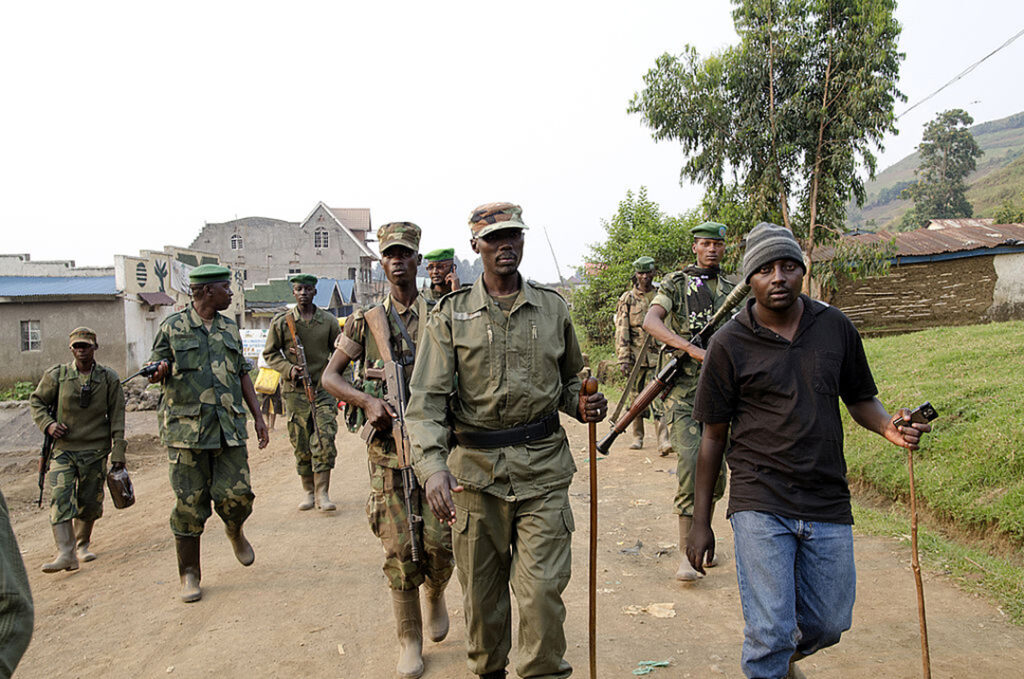ADF STAFF
Tens of thousands of residents fled the town of Bunagana in eastern Democratic Republic of the Congo (DRC) when M23 rebels seized it in June.
“They are all over, the streets are full, others have gone to churches, they are under trees, everywhere,” Ugandan district commissioner Shaffiq Sekandi told Reuters news service of the refugees. “It’s a really desperate situation.”
Bunagana, a major commercial hub on the border with Uganda, remains in the hands of M23 months later.
The rebels, named after a failed peace deal signed on March 23, 2009, trace their lineage from Congolese rebel groups that formed in the 1990s, when refugees and perpetrators of the Rwandan genocide streamed over the border and triggered regional conflicts in the DRC.
After lying dormant for nearly a decade, M23’s resurgence is just the latest crisis in the eastern provinces of the DRC, which have seen constant conflict for decades.
The new offensive began while Congolese and Ugandan forces collaborated hundreds of kilometers to the north to flush out a terror group called the Allied Democratic Forces, which has links to the Islamic State group.
With those militaries occupied, M23 stormed into a security vacuum in the densely forested, mountainous region where the borders of the DRC, Uganda and Rwanda converge.
Experts believe M23 hopes to force negotiations into the DRC government’s new disarmament, demobilization and reintegration (DDR) program, which has been offered to dozens of militias that have destabilized the region for years.
However, the DRC has excluded M23 and the Allied Democratic Forces from the DDR program, instead designating both as terrorist groups.
“When a new DDR program was announced, it was an opportunity for the M23 to push their agenda,” Congo Research Group Director Jason Stearns told The New Humanitarian.
Stearns said reports from the field and analysis of the rebels’ firepower “suggest that it’s very likely” Rwanda is backing M23’s offensive.
United Nations special envoy for the DRC Bintou Keita told the Security Council in late June that “during the most recent hostilities, the M23 has conducted itself increasingly as a conventional army rather than an armed group.”
Rwandan nationals wearing military uniforms have been spotted among M23’s ranks.
“The M23 possesses firepower and equipment, which is increasingly sophisticated, specifically in terms of long-range fire capacities, mortars and machine guns as well as precision fire against aircraft,” she said.
“The threat that this poses both for civilians and MONUSCO [the U.N. peacekeeping mission in the DRC], who have a mandate to protect them, is evident.”
The U.N. has accused Rwanda and Uganda of aiding M23. Both countries repeatedly have denied involvement with the rebel group.
Since 1998, more than 5.4 million people in the region have died as a result of numerous wars and conflicts. Currently, there are nearly 6 million internally displaced persons in the DRC, according to the U.N.
Eastern DRC teems with mineral wealth that militias, rebel groups and neighboring countries seek to extract.
But at the heart of the violence are explosive ethnic tensions.
Rwanda-based independent political analyst Gatete Nyiringabo Ruhumuliza said the people known as “Banyarwanda” have been at the center of conflict in eastern DRC for nearly three decades.
The word Banyarwanda means “people of Rwandan origin” and often refers to Rwandans who emigrated to the DRC’s North Kivu province between the end of World War I and 1960.
“Those of Kivu South are commonly known as ‘Banyamulenge,’” Ruhumuliza wrote in an August 2022 article in the Kenyan newspaper The East African. “‘Banya’ meaning ‘people of,’ they simply took up names of their localities.
“While the majority of the Banya in these [places] identify as Hutu, those who identify as Tutsi — the minority — have struggled to be accepted. As a result, ‘Banyarwanda’ is often used to exclude the Tutsi.”
Both ethnicities have been in the eastern DRC for more than a century, but at times each has been persecuted and perceived as noncitizens.
More than 1 million refugees fled the Rwandan genocide in 1994, including hundreds of thousands of Hutus. Many genocidal killers were among them.
Today, ethnic battles continue in eastern DRC.
M23 is made up primarily of Tutsis, although many Tutsis in the region oppose the rebel group.
Whether M23 members operate as a proxy for foreign interests or genuinely seek citizenship and amnesty in the DRC, the rebels insist they are not going away.
“We are going to stay where we are waiting for the agreement we made [with the government] to be implemented,”spokesperson Willy Ngoma told the BBC on August 18. “If they want to revive the talks, we are ready.
“But if they attack us again, we will defend ourselves.”

